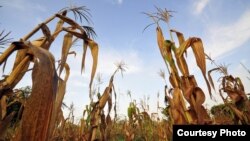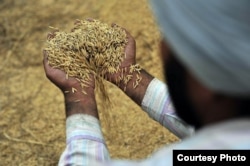Climate change might force changes in diets around the world as certain staple foods become harder to produce, according to international agriculture researchers.
However, future shortfalls could be offset by switching to crops which can thrive in those altered climates, according to new reports by the Consultative Group on International Agriculture Research.
Important crops like maize and wheat produce less grain at temperatures above 30 degrees Celsius.
“Those kinds of temperatures are being reached on a regular basis and more frequently in many countries now,” says Sonja Vermeulen, head of CGIAR climate change research.
Widespread changes
Vermeulen says growing-season temperatures are not the only factors affected by climate change. Rainfall patterns are shifting, too. Water supplies will be strained in some areas, while others will see more floods.
Climate change is also altering habitats for pests and diseases, she says. "And for some crops, particularly crops we really value, such as potatoes, we think those are really likely to increase and change in their patterns in the future.”
Rice will not be spared, either. Higher temperatures, salt water encroachment, more flooding and more droughts are likely as the climate changes.
Maize vs. millet
Some crops in some regions will be able to adapt, “But for others, we’re really going to have to think about switching out of growing some crops entirely,” Vermeulen says.
For example, by later this century large parts of Africa will no longer be suitable for growing maize. Sorghum, millet and cassava are becoming better options.
“And when you start thinking through all that, it means changes in people’s diets," she says. "And these are fairly fundamental cultural changes.”
Vermeulen and her colleagues have just released two reports outlining the predicted impacts of climate change on food production, and also on food safety. She says warmer temperatures will mean foods will spoil faster.
“This is something we haven’t thought a lot about, these kinds of infections that can harm humans that really might be on the increase,” she says.
Global vs. local
But not all the news from climate change is bad. Many farmers will adapt, and new farmland will open up in what used to be colder latitudes. So overall, the global food supply may not suffer.
But, Vermeulen says, what will matter most to people is what happens when local crops begin to fail.
“Are we going to deal with that by greater global interconnectivity so that people can shift out of agriculture but buy their food from somewhere else," she asks, "or do we deal with it by major changes in how people are growing food, raising animals and eating?”
Over the next 100 years, she says, the world will need to do a bit of both: expand global trade, and adapt local farms to the realities of climate change.
However, future shortfalls could be offset by switching to crops which can thrive in those altered climates, according to new reports by the Consultative Group on International Agriculture Research.
Important crops like maize and wheat produce less grain at temperatures above 30 degrees Celsius.
“Those kinds of temperatures are being reached on a regular basis and more frequently in many countries now,” says Sonja Vermeulen, head of CGIAR climate change research.
Widespread changes
Vermeulen says growing-season temperatures are not the only factors affected by climate change. Rainfall patterns are shifting, too. Water supplies will be strained in some areas, while others will see more floods.
Climate change is also altering habitats for pests and diseases, she says. "And for some crops, particularly crops we really value, such as potatoes, we think those are really likely to increase and change in their patterns in the future.”
Rice will not be spared, either. Higher temperatures, salt water encroachment, more flooding and more droughts are likely as the climate changes.
Maize vs. millet
Some crops in some regions will be able to adapt, “But for others, we’re really going to have to think about switching out of growing some crops entirely,” Vermeulen says.
For example, by later this century large parts of Africa will no longer be suitable for growing maize. Sorghum, millet and cassava are becoming better options.
“And when you start thinking through all that, it means changes in people’s diets," she says. "And these are fairly fundamental cultural changes.”
Vermeulen and her colleagues have just released two reports outlining the predicted impacts of climate change on food production, and also on food safety. She says warmer temperatures will mean foods will spoil faster.
“This is something we haven’t thought a lot about, these kinds of infections that can harm humans that really might be on the increase,” she says.
Global vs. local
But not all the news from climate change is bad. Many farmers will adapt, and new farmland will open up in what used to be colder latitudes. So overall, the global food supply may not suffer.
But, Vermeulen says, what will matter most to people is what happens when local crops begin to fail.
“Are we going to deal with that by greater global interconnectivity so that people can shift out of agriculture but buy their food from somewhere else," she asks, "or do we deal with it by major changes in how people are growing food, raising animals and eating?”
Over the next 100 years, she says, the world will need to do a bit of both: expand global trade, and adapt local farms to the realities of climate change.








